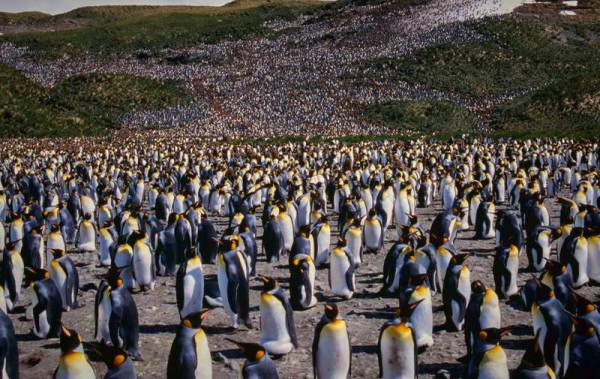While Instagram might be filled with lots of people sharing photos of the exotic destinations they’re visiting for summer, there are still certain places on the planet earth where people are not allowed to visit.
Whether for dangerous reasons, such as the presence of poisonous creatures or lingering diseases, or because they are holy sites only open to royal families, or natural wonders that could collapse at any moment, many sites are closed off permanently to the public.
From caves dating back 17,000 years to an island whose tribal inhabitants are known to kill those who venture too close, here are 10 places on the planet you can never set foot.
Ilha da Queimada Grande, Brazil
Known globally as Snake Island, Ilha da Queimada Grande was once inhabited by people who left in the 1920s when the island’s lighthouse was automated.
Since then, it is strictly off limits to the public as it is now estimated to be home to one snake for every square metre of the island — of which there are 430,000 square metres.
Home to the venomous golden lancehead viper among other species, only the Brazilian Navy and biomedical research teams are permitted to land there.
Lascaux Caves, France
Since 1963, visitors have been banned from the Lascaux Cave complex in the Dordogne, south-west France.
A Unesco World Heritage site, the caves were discovered by four teenagers in 1940 and opened to the public eight years later for visitors to marvel at the prehistoric art on the walls, which dates back more than 17,000 years to the Palaeolithic era.
Featuring almost 6,000 images drawn using mineral and manganese pigments, as well as charcoal, the art was adversely affected by the carbon dioxide and heat generated by the visitors causing mould to grow.
Replica caves built nearby attract thousands of visitors a year.
Heard Island and McDonald Islands, Australia
Among the most remote places on the planet, Heard Island and McDonald Islands can only be reached by boat, a journey which takes two weeks sailing south-west from Perth, Australia.
Located between Madagascar and Antarctica, the islands were only discovered in the mid-19th century and are home to penguins and marine birds, as well as an array of flora and fauna.
They are closed to the public owing to lava flow from the island's volcano, Mawson's Peak, and because of adverse weather conditions.
North Brother Island, New York, the US
Slap bang in the middle of one of the most-visited cities on Earth is a 13-acre island that no one is allowed to set foot on.
North Brother Island sits between the Bronx and the Rikers Island prison complex on the East River. It was once home to a hospital for contagious diseases, the most famous patient of which was Mary Mallon, also known as Typhoid Mary, who was confined there for two decades and was believed to have infected at least 51 people with the fever.
Left to nature, the island has since become a bird sanctuary with access only granted for academic or research purposes.
Ise Grand Shrine, Japan
Located in Ise on Honshu island, the Ise Grand Shrine is a Shinto shrine complex dedicated to the sun goddess Amaterasu, thought to date back to 4 BC.
Said to be the site of a sacred mirror, stories of which go back centuries, no members of the public are allowed to set foot inside.
Only priests, priestesses and members of the imperial family of Japan are permitted to enter the shrine, which is rebuilt every 20 years in accordance with the Shinto belief of the death and renewal of nature.
North Sentinel Island, India
The island in the Bay of Bengal is home to the Sentinelese tribe, who have called North Sentinel home for at least 30,000 years.
The tribe live in voluntary isolation from the rest of the world and a government act forbids any travel to the island or approaches closer than five nautical miles (9.26 km), with the area patrolled by the Indian Navy.
The indigenous tribe are known to shoot arrows at boats approaching their island and have killed three men over the past two decades who broke the law to venture closer.
Niihau Island, Hawaii, the US
The 2020 US census put the population of this island, which sits 28.2km south-west of Kauai, at just 84.
Dubbed the “Forbidden Island”, it was bought from the Kingdom of Hawaii in 1864 by a Scottish farmer and plantation owner called Elizabeth Sinclair for $10,000. Access is only granted to the US Navy, which maintains a small unmanned station there, government officials and descendants of Sinclair, which includes current owners, the Robinson family.
The Robinson family’s conservation efforts have seen the island, which was noted as “treeless” by Captain James Cook in 1778, now designated as a critical habitat for many Hawaiian species.
Pravcicka Brana, Czech Republic
Part of the Elbe Sandstone Mountains, which lie between Germany and the Czech Republic, Pravcicka Brana is a natural sandstone arch 16 metres above the ground.
Once a popular tourist spot, with an inn and the Hotel Sokoli hnizdo built there in the 1800s, the arch has been closed permanently to visitors since 1982.
Officials say the sheer number of visitors accelerated erosion at the site, creating concerns it would collapse, which it will one day, but will be due to the effects of the elements and natural decay rather than humans.
Surtsey, Iceland
As far as islands go, Surtsey off the south coast of Iceland is still a planetary newcomer, having only been formed between 1963 and 1967 thanks to an underwater volcanic eruption.
The island is off limits to the public, with only researchers able to gain access to study how ecosystems might develop without human influence, and is estimated to disappear beneath the waves by the next century.
Bhangarh Fort, Rajasthan, India
An outlier on this list, the Bhangarh Fort is open during the day for tourist and visitors. However, come sunset, access to the 16th century fort is strictly prohibited. The restrictions stem from local folklore, which says those who have ever ventured inside in the dark are never seen again.
Legend has it that the fort, which was built by Kachwaha ruler of Amber, Raja Bhagwant Singh in 1573, was cursed by a hermit and sage named Guru Balu Nath after a promise was broken not to allow the fort’s shadow to encroach on Nath’s meditation space.
It has been dubbed “the most haunted fort in India”.
Source: Thenationalnews
Would you risk visiting any of these places or rather explore other tourist sites, lets know your thoughts on the comment section.







 Share This Post To Your Friends Using The Share Buttons Below.
Share This Post To Your Friends Using The Share Buttons Below.
No comments:
Post a Comment